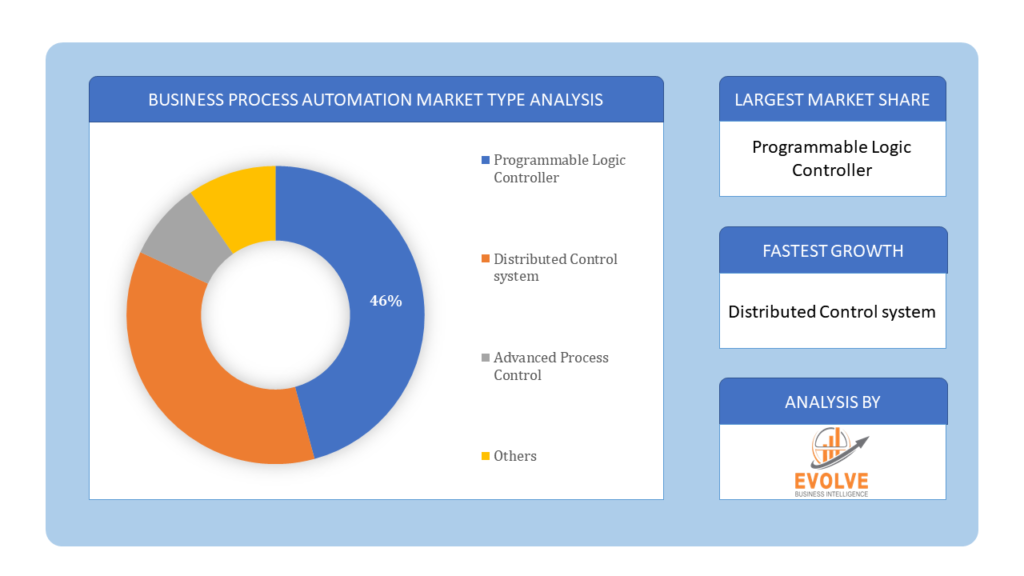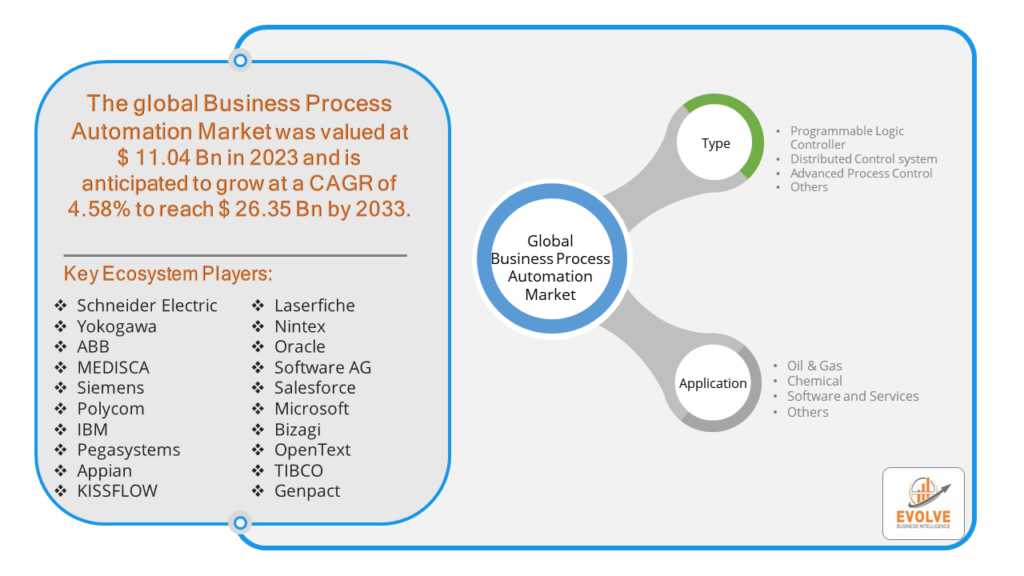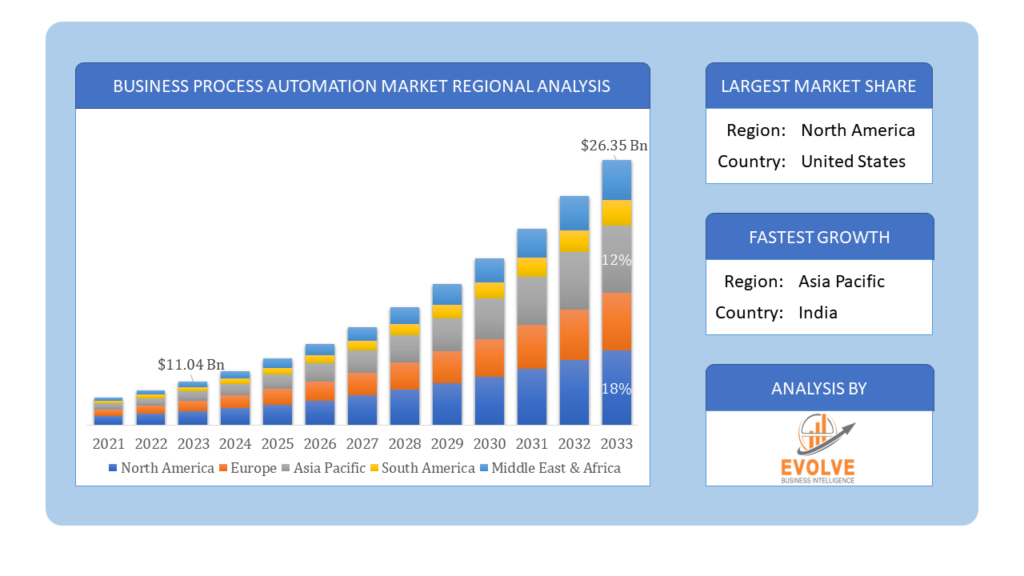Business Process Automation Market Overview
The Business Process Automation Market Size is expected to reach USD 26.35 Billion by 2033. The Business Process Automation industry size accounted for USD 11.04 Billion in 2023 and is expected to expand at a compound annual growth rate (CAGR) of 4.58% from 2023 to 2033. Business process automation (BPA) refers to the application of technology to automate business processes with minimal human intervention. It aims to increase efficiency, productivity, and profitability by automating tasks, reducing manual processing, and improving data analytics. BPA involves the use of platforms and services to automate various functions such as human resource management, supply chain management, sales and marketing, accounting and finance, and customer service support.
Global Business Process Automation Market Synopsis
The COVID-19 pandemic has led to supply chain disruptions leading to supply shortages or lower demand in the Business Process Automation market. The travel restrictions and social-distancing measures have resulted in a sharp drop in consumer and business spending and this pattern is to continue for some time. The end-user trend and preferences have changed due to the pandemic and have resulted in manufacturers, developers, and service providers to adopt various strategies to stabilize the company.
Business Process Automation Market Dynamics
The major factors that have impacted the growth of Business Process Automation are as follows:
Drivers:
Ø Efficiency and Cost Reduction
One of the primary drivers for BPA is its ability to streamline workflows and processes, leading to enhanced operational efficiency and significant cost savings. By automating repetitive tasks and reducing human intervention, organizations can allocate resources more effectively and achieve higher productivity.
Restraint:
- Cybersecurity Risks
Automation introduces new cybersecurity vulnerabilities, such as data breaches, unauthorized access, and malware attacks. Protecting sensitive information and ensuring compliance with data protection regulations are critical considerations for BPA implementations.
Opportunity:
⮚ Cost Savings and Return on Investment (ROI)
Despite initial investment costs, BPA delivers long-term cost savings through reduced labor expenses, improved resource allocation, and operational efficiencies. Organizations can achieve significant ROI by automating high-volume and repetitive tasks.
Business Process Automation Segment Overview
By Type
 Based on Type, the market is segmented based on Program mable Logic Controller, Distributed Control System, Advanced Process Control, Others. Among these, PLCs dominate due to their widespread use in industrial automation for controlling machinery and processes, while APC is increasingly critical for optimizing complex process operations.
Based on Type, the market is segmented based on Program mable Logic Controller, Distributed Control System, Advanced Process Control, Others. Among these, PLCs dominate due to their widespread use in industrial automation for controlling machinery and processes, while APC is increasingly critical for optimizing complex process operations.
By Application
Based on Applications, the market has been divided into the Oil & Gas, Chemical, Software and Servicess, Others. The Business Process Automation Market is segmented based on applications, with the Software and Services segment dominating the market, followed by the Oil & Gas and Chemical segments
Global Business Process Automation Market Regional Analysis
Based on region, the global Business Process Automation market has been divided into North America, Europe, Asia-Pacific, the Middle East & Africa, and Latin America. North America is projected to dominate the use of the Business Process Automation market followed by the Asia-Pacific and Europe regions.
 Business Process Automation North America Market
Business Process Automation North America Market
North America holds a dominant position in the Business Process Automation Market. The process automation and instrumentation market in North America, which was valued at USD 1.7 billion in 2022, is anticipated to rise at a substantial compound annual growth rate (CAGR) throughout the course of the research. The Fourth Industrial Revolution’s cutting-edge innovations are being spearheaded by the United States, which is renowned for its inventiveness.
Business Process Automation Asia-Pacific Market
The Asia-Pacific region has indeed emerged as the fastest-growing market for the Business Process Automation industry. From 2024 to 2032, the Asia-Pacific Process Automation and Instrumentation Market is anticipated to develop at the quickest compound annual growth rate (CAGR). This is because government initiatives to support automated technologies are becoming more focused, as is the growth of information technology and large-scale domestic production. In addition, China’s market for process automation and instrumentation had the most market share, while India’s market had the quickest rate of growth in the Asia-Pacific area.
Competitive Landscape
The global Business Process Automation market is highly competitive, with numerous players offering a wide range of software solutions. The competitive landscape is characterized by the presence of established companies, as well as emerging startups and niche players. To increase their market position and attract a wide consumer base, the businesses are employing various strategies, such as Type launches, and strategic alliances.
Prominent Players:
- Schneider Electric
- Yokogawa
- ABB
- MEDISCA
- Siemens
- Polycom
- IBM
- Pegasystems
- Appian
- KISSFLOW
- Laserfiche
- Nintex
- Oracle
- Software AG
- Salesforce
- Microsoft
- Bizagi
- OpenText
- TIBCO
- Genpact
Key Development
In September 2022, IBM announced enhancements to its IBM Automation platform, integrating AI capabilities to further streamline business processes and improve decision-making, thereby advancing its leadership in the Business Process Automation market.
Scope of the Report
Global Business Process Automation Market, by Type
- Programmable Logic Controller
- Distributed Control system
- Advanced Process Control
- Others
Global Business Process Automation Market, by Application
- Oil & Gas
- Chemical
- Software and Services
- Others
Global Business Process Automation Market, by Region
- North America
- US
- Canada
- Mexico
- Europe
- UK
- Germany
- France
- Italy
- Spain
- Benelux
- Nordic
- Rest of Europe
- Asia Pacific
- China
- Japan
- South Korea
- Indonesia
- Austalia
- Malaysia
- India
- Rest of Asia Pacific
- South America
- Brazil
- Argentina
- Rest of South America
- Middle East & Africa
- Saudi Arabia
- UAE
- Egypt
- South Africa
- Rest of Middle East & Africa
| Parameters | Indicators |
|---|---|
| Market Size | 2033: $26.35 Billion |
| CAGR | 4.58% CAGR (2023-2033) |
| Base year | 2022 |
| Forecast Period | 2023-2033 |
| Historical Data | 2021 |
| Report Coverage | Revenue Forecast, Competitive Landscape, Growth Factors, and Trends |
| Key Segmentations | Type, Application |
| Geographies Covered | North America, Europe, Asia-Pacific, Latin America, Middle East, Africa |
| Key Vendors | Schneider Electric, Yokogawa, ABB, MEDISCA, Siemens, Polycom, IBM, Pegasystems, Appian, KISSFLOW, Laserfiche, Nintex, Oracle, Software AG, Salesforce, Microsoft, Bizagi, OpenText, TIBCO and Genpact. |
| Key Market Opportunities | • Growing Opportunities in Industry 4.0 |
| Key Market Drivers | • Rising Focus of Manufacturing Firms Towards Achieving Better Costs Increasing Focus on Energy Efficiency |
REPORT CONTENT BRIEF:
- High-level analysis of the current and future Business Process Automation market trends and opportunities
- Detailed analysis of current market drivers, restraining factors, and opportunities in the future
- Business Process Automation market historical market size for the year 2021, and forecast from 2023 to 2033
- Business Process Automation market share analysis at each Type level
- Competitor analysis with detailed insight into its Type segment, Government & Defense strength, and strategies adopted.
- Identifies key strategies adopted including Type launches and developments, mergers and acquisitions, joint ventures, collaborations, and partnerships as well as funding taken and investment done, among others.
- To identify and understand the various factors involved in the global Business Process Automation market affected by the pandemic
- To provide a detailed insight into the major companies operating in the market. The profiling will include the Government & Defense health of the company’s past 2-3 years with segmental and regional revenue breakup, Type offering, recent developments, SWOT analysis, and key strategies.








